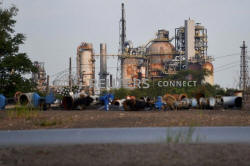Cause of Philadelphia fire sounds alarm over aging U.S.
refineries
 Send a link to a friend
Send a link to a friend
 [November 06, 2019] By
Laila Kearney [November 06, 2019] By
Laila Kearney
PHILADELPHIA (Reuters) - How did a piece of
piping installed when Richard Nixon was U.S. president go without once
being checked before leading to a fire that devastated the East Coast's
largest and oldest oil refinery?
That's a question safety experts and activists are putting to regulators
after the devastating fire at the Philadelphia Energy Solutions (PES)
refinery in June, worried more disasters are waiting to happen in an
industry reliant on old equipment.
Last year, U.S. refiners processed nearly 17 million barrels of crude
oil every day, the most in the country's history as it cashes in on a
boom in shale oil.
But many have decades-old infrastructure, risking outages that could
cost the industry billions.
The PES refinery is one of nearly 30 in the United States that are more
than a century old, while a Reuters review of over 100 operating U.S.
refineries that process more than 10,000 barrels of crude oil a day
showed they are on average 80 years old. [GRAPHIC: Aging U.S.
refineries: https://tmsnrt.rs/33guhA8]

Refineries frequently update their systems and replace old parts, but
the PES fire, along with incidents in Washington state and California
earlier this decade, stemmed from equipment installed in the 1970s that
had been allowed to run to failure, according to U.S. Chemical Safety
Board (CSB) reports.
The suspected cause of the PES explosion has raised fears about future
incidents because of the leeway given to refiners for inspecting parts,
and because some older equipment is exempt from more stringent standards
for newly installed parts.
"A lot of these refineries around the U.S. are quite old now," said
former CSB managing director Daniel Horowitz, who left the agency last
year. "That doesn't mean that every single piece of equipment dates back
to the founding, but they are old and eventually all sorts of components
can fail."
The June 21 Philadelphia blaze was linked to corroded piping that had
not been checked since it was installed in 1973, according to the CSB's
initial findings. The fire is still under investigation by the CSB and
other public agencies.
It caused a fuel leak and explosions that sent toxic hydrofluoric acid (HF)
into the air and hurled debris the size of a tractor-trailer across a
nearby river, the CSB's report said.
Shortly after the fire, PES filed for bankruptcy protection.
Failing, decades-old equipment also sparked a 2010 Tesoro refinery
explosion in Anacortes, Washington, that killed seven people, and a
Chevron refinery blast in Richmond, California, two years later,
according to past CSB reports.
In all three cases, the failed equipment contained metal components or
designs that were no longer up to industry standards, but their use did
not necessarily violate regulations. Regulators offer exemptions for
older components, and do not require all pieces of plant machinery to be
checked.
"That's a huge problem in this sector, that a lot of codes allow
grandfathered equipment to be used even if later standards would have
prohibited it," said Horowitz.
The CSB report spurred a letter from top law enforcement official in 13
states, including Pennsylvania, to the U.S. Environmental Protection
Agency (EPA), arguing against a proposed rollback of regulations aimed
at preventing accidents involving chemicals such as HF.
GRANDFATHERED IN
Regulators overseeing U.S. oil refinery safety, primarily the U.S.
Occupational Safety and Health Administration (OSHA) and the EPA, and
code-setting industry groups allow some refinery components to keep
being used even if they don't meet newer standards.
[to top of second column] |

The Philadelphia Energy
Solutions plant refinery is seen in Philadelphia, Pennsylvania,
U.S., August 21, 2019. REUTERS/Mark Makela/File Photo

The EPA and OSHA were not available for comment.
The ruptured PES pipe contained levels of nickel and copper that were permitted
when installed, but not under recommendations made two decades later by the
American Society for Testing and Materials, now called ASTM International, that
still stand, according to the CSB. That pipe elbow corroded at a faster rate
than other pieces of the system.
Oil industry group the American Petroleum Institute (API) has about 175
recommended codes that act as the refinery industry's standards. The API
inspection standards for HF alkylation units used in about one-third of U.S.
refineries do not call for every piping component to be inspected.
API spokesman Scott Lauermann said that its standard for HF units was recognized
as the safest way to operate those units, having been recommended by the CSB.
PES said it monitored other parts of the piping system according to industry
standards, including an examination of a metal elbow near the one that ruptured,
and the testing did not show high levels of corrosion.
"PES would not have expected the piping to corrode at different rates because
the elbows were installed at the same time and the construction specifications
indicated that they were the same materials of construction," PES vice president
of strategy and business development Mark Brandon said via email.
The CSB findings added to existing concerns by workers about maintenance at the
PES refinery, which was already struggling financially, and in January cut back
the scope of a planned large-scale maintenance project days before it was
scheduled to begin.

PES business agents and managers told union officials and major contractors the
work would require between 1,500 and 1,800 contract workers, but that was
slashed to just 300 contractors, according to five sources familiar with the
plan, while pipes and other materials delivered to the plant were never used.
A VACUUM
Maintaining and inspecting equipment at refineries is required by the OSHA and
EPA, but those agencies don't tell refineries how or when to inspect. Those
details are filled in by industry standards that may not have the enforcement of
law.
The CSB found that prior to the California and Washington fires, as well as the
BP Texas City blast in 2005 that killed 15, internal and external instructions
for keeping plants operating safely were either ignored or not followed
correctly.
That regulatory approach makes rules difficult to enforce and allows problems at
refineries to go undiscovered, said Jeff Ruch of environmental advocacy group
Public Employees for Environmental Responsibility.
In the aftermath of the Washington explosion, a judge dismissed $2.4 million in
fines against Tesoro because the state could not prove the refinery failed to
comply with enforceable rules for inspection and maintenance of equipment.
"In terms of, are we making sure in some sort of holistic way that these
refineries are safe, there's nothing there," said Ruch. "There's sort of a
vacuum."
(Reporting by Laila Kearney; Editing by Mark Potter)
[© 2019 Thomson Reuters. All rights
reserved.] Copyright 2019 Reuters. All rights reserved. This material may not be published,
broadcast, rewritten or redistributed.
Thompson Reuters is solely responsible for this content. |